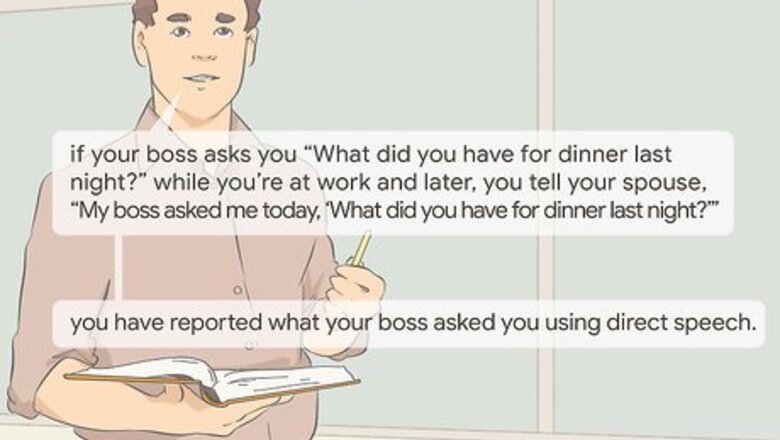
views
Explaining Direct and Indirect Speech

Define direct speech so your students will understand what it means. When teaching your students reported speech, it’s important that you first explain to them what direct speech is so they can better understand how to use it. Specifically, explain to them that direct speech is when a speaker reports what someone else said exactly as the original speaker said it. For example, if your boss asks you “What did you have for dinner last night?” while you’re at work and later, you tell your spouse, “My boss asked me today, ‘What did you have for dinner last night?’,” you have reported what your boss asked you using direct speech.

Explain the definition of indirect speech and how it's different from direct speech. Explain to your students that indirect speech, unlike direct speech, is when a speaker reports what someone else said in their own words without changing the original speaker’s meaning. For example, if your boss asks you “What did you have for dinner last night?” while you’re at work and later, you tell your spouse, “My boss asked me what I had for dinner last night,” you’ve used indirect speech to report what your boss asked you. Indirect speech often is marked by the word "that" before the clause containing what the other person said.
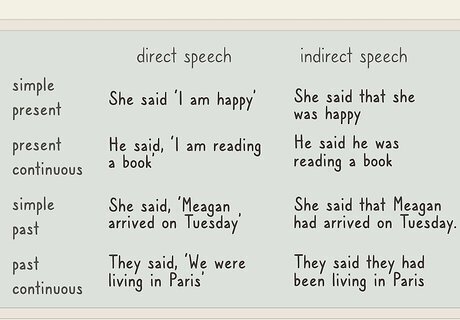
Clarify how verb tenses change from direct to indirect speech. When explaining to your students how to report using direct and indirect speech, it’s important that they understand what tense they should use for various types of sentences. Therefore, it can be helpful to provide them with some general rules about what tense to use when converting direct speech to indirect speech. Here are a few of the general rules about reporting to explain to your students: When using direct speech to report, the tenses of the verbs within the quotations do not change, since direct speech involves an exact recitation of the original words spoken. Simple present tense direct speech changes to simple past tense indirect speech. For example, “She said ‘I am happy’” becomes “She said that she was happy.” Present continuous direct speech changes to past continuous tense in indirect speech. For example, “He said, ‘I am reading a book’” becomes “He said he was reading a book.” Simple past tense direct speech changes to past perfect tense in indirect speech. For example, “She said, ‘Meagan arrived on Tuesday’” becomes “She said that Meagan had arrived on Tuesday.” Past continuous tense direct speech changes to past perfect continuous tense indirect speech. For example, “They said, ‘We were living in Paris’” changes to “They said they had been living in Paris.”
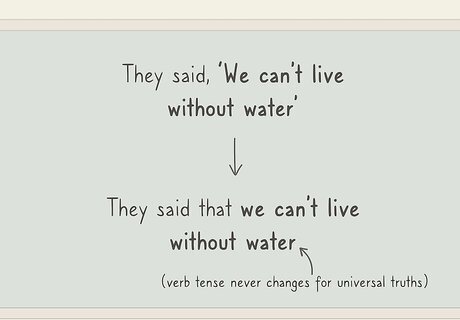
Explain that verb tense never changes for universal truths. When explaining to your students how to use direct and indirect speech, it’s important that you make clear that if the words within the quotation talk about a universal truth, the tense does not change from direct to indirect speech. Because universal truths are always true, there is no need to alter the tense. For example, when converted to indirect speech, the direct speech sentence “They said, ‘We can’t live without water’” becomes “They said that we can’t live without water” because the words spoken are a universal truth.
Using Activities to Teach Reported Speech
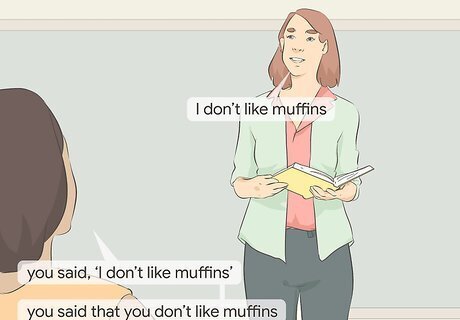
Have your students rephrase sentences using reported speech. First, call on one of your students and read out a simple sentence. Then, have the student report the information back to you first using direct speech, then using indirect speech. Repeat this process with a different sentence for each student until all the students have successfully reported back to you using both direct and indirect speech. For example, you could read out the sentence, “I don’t like muffins.” The student should then report this information back to you, stating it first in direct speech (“you said, ‘I don’t like muffins’”), followed by indirect speech (“you said you don’t like muffins”).

Ask your students to report on each other’s answers to your questions. First, ask one student a question. Once they answer, ask another student to report what the first student said using direct speech. Then, ask a third student to report what the first student said using indirect speech. Repeat this with new questions until all of your students have reported using both direct and indirect speech.

Prepare index cards for a reported speech role-play activity. First, count out the number of index cards that you have students and write a different sentence on each index card. Hand each student a card. Then, have them go around the room and read their card to other students before sitting back down. You can then go around the room and ask each student to report back on what other students said to them using either direct or indirect speech. The sentences can be statements, questions, or a mix of both. For example, you could write “Do we know each other?” on an index card. Hand this card to one student and have them read it to a second student. Then, ask the second student to report what the first student read to them. The second student should then respond using direct speech (“She asked me, ‘Do we know each other?’”) or indirect speech (“She asked me if we know each other”). You can make this activity a bit more fun by telling the students to pretend they are at a party where everyone must circulate and talk to each other.

Get your students to correct a story using reported speech. First, write a statement on the board and read it out loud. Then, tell your students that you are going to tell them a short story, and that they should interrupt you if you say anything that contradicts the statement written on the board. Go on to tell a short story that contradicts the statement written on the board. Once you contradict the statement and the students interrupt you, have them ask for clarification using direct or indirect speech. For example, write “I live in a big house” on the board. Then, tell a short story stating “I bought a new dining table but it was too big for my small apartment so I had to get another one.” The students will interrupt you after stating that you live in a small apartment. You can then have the students ask for clarification using direct (“But didn’t you say, “I live in a big house”?) or indirect speech (“Didn’t you say you lived in a big house?”).
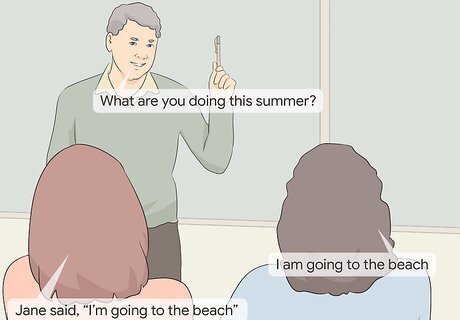
Play reported speech telephone for a fun learning activity. Begin by asking one student a question. Have them answer the question out loud. Then, have a second student report to a third student on what the first student said using direct speech. Have the third student report to a fourth student on what the first student said using indirect speech. Keep this going until all the students have reported on the first student’s answer to your question. For example, ask the first student “What are you doing this summer?” and have them answer to a second student “I am going to the beach.” Then, have the second student report to a third student on what the first student said using direct speech (“John said, “I’m going to the beach”). The third student will then report to a fourth student using indirect speech (“Katie said that John said that he’s going to the beach”) and so on until all the students have had a turn.




















Comments
0 comment